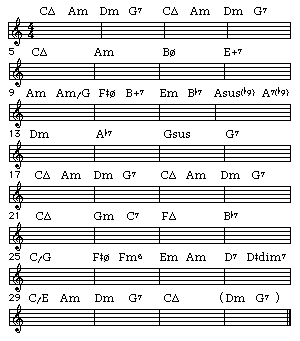
[from JPSL No. 20]
In the classic slow ballad, the time is simultaneously moving at numerous different meters, each of which may come to the fore at different times, but which remain implicit underneath the music throughout. Within those meters, there are potentially different levels of swing occurring, and the basically slow pulse of the music allows all these temporal facets to interact much more richly than they do in medium or up tempo jazz, although the same principles apply there too.
The relationship between metrical rhythm (i.e. rhythm in the ordinary sense) and harmonic rhythm--that they are really aspects of the same thing--is especially significant in ballads. In ballads containing sections of contrasting harmonic rhythm, the harmonic rhythm dictates the feel of each section.
Like the complex pattern of a Persian rug, the interest of the music depends on this metrical richness; without it the slow tempo would risk tedium.
Let me use Time After Time as an example for study. Here are the changes for this standard.

| There are charts in Dick Hyman's Professional Chord Changes and Substitutions for 100 Tunes Every Musician Should Know(Ekay Music), an excellent fake book; The Original #2 fake book; America's Best Loved Songs, an Encyclopaedia of the Great Standards; and The Real Book, Vol. II. The tune has been widely recorded in recent years. I recommend it. |
The examples below are supposed to be bits of improvisation.
The fundamental pulse, or "ground beat", is the quarter note. (I'm speaking of the classic slow ballad in 4/4; the same analysis with appropriate alterations will apply to different types of ballad.) The natural swing in 4/4 at this tempo (about quarter note = 92) calls for about a 3:2 ratio, that is
[Ex. 1]

(this is a feel, not a counted-out metrical thing).
The shift of harmonic rhythm in m. 5 comes as quite a surprise to the sight-reader. The natural feel changes to a half-note pulse, and the swing subdivision will be in triplet quarter-notes. At such a slow rate only an actual triplet makes sense; although it could be argued that this is not really a "swing" rhythm, it is nevertheless the triplet quarter note that establishes the half-note pulse. Bar 5-7:
[Ex. 2]

As you play through the tune--even if you don't have a chart, you can just improvise on these changes--you can feel the subtle ongoing interplay between the quarter- and the half-note pulse. I don't need to give a detailed analysis; just observe how the II-V-I in Emi, m. 10-11, is half the length of the II-V-I in Dmi that follows, m. 11-13. (Don't be misled by the interpolation of a substitute chord, the Bb7.) You will find that in the last line an expectation to return to the slower time is somehow set up, so that the return to the top seems unexpectedly fast-moving. To play the tune effectively, you have to understand these twists and set them up accordingly.
But to return to my main line of thought--as we improvise, the demand for variety requires development of other layers of time. Besides the swing eighths in 4/4 time, there are also 16ths, and the straight eighths that are evoked by them.
[Ex. 3]

On the other hand the use of exact triplets--and their cross-rhythms--is also a time feel distinct from the swing eighths.
[Ex. 4]

In the other direction, at times a triplet half-note can be an effective tension builder. This can be like a cross-rhythm of quarter note triplets.
[Ex. 5]

(To get the feel of these examples you should extend them for several bars.)
In a tune like Time After Time, there is a particular reason to use the different time feel possibilities as a creative element: the repetitiveness of the changes. Out of 32 bars, a good 14 are taken up with a basically static turnaround progression in the home key. In particular, the return to I at m. 5 and at m. 21 poses a danger to your solo of bogging down. The most powerful way of dealing with this problem is to express dramatic forward motion through variations in time feel.
The opposite of the "expected" feel can be equally effective. To counter the languor of the 1-chord-per-bar passages, such as m. 5-8, you can use a driving eighth-note swing, and likewise where there are two chords per bar use quarter-note triplet feel.
There is a further reason to think of "nested" time in ballads. A trap that students fall into is to conceive of a ballad exclusively at a slow quarter-note feel, and with no subdivisions supporting the time there is a serious danger of losing the beat and drifting into an unintended rubato. Feeling the subdivisions keeps the tempo correct. I often start off a slow ballad, such as A Child Is Born,
[Ex. 6]

without sounding any note quicker than a quarter note, but in my mind feeling pulsing 16th notes, or perhaps triplet or swing 8ths. I might continue this for quite some time. The dance of the time has an unusual intensity when I do this, and I think the time concept is communicated to my rhythm players especially well. Eventually, some actual 16ths will escape; since the inner time has been well-established, they have a "right" feeling .
Paradoxically, the more levels on which you feel the time flow, the more solid and reliable the feeling is.
A similar idea can enlighten up-tempo playing as well. For one thing, exactly the same concept applies; it is just a little less significant, while accents and note-groupings into phrases come more to the fore. But beyond that, the nesting idea applies in the other direction--the time is also felt as if each bar was a beat, and 4- and 8-bar phrases become a part of the rhythm as well as of the form.